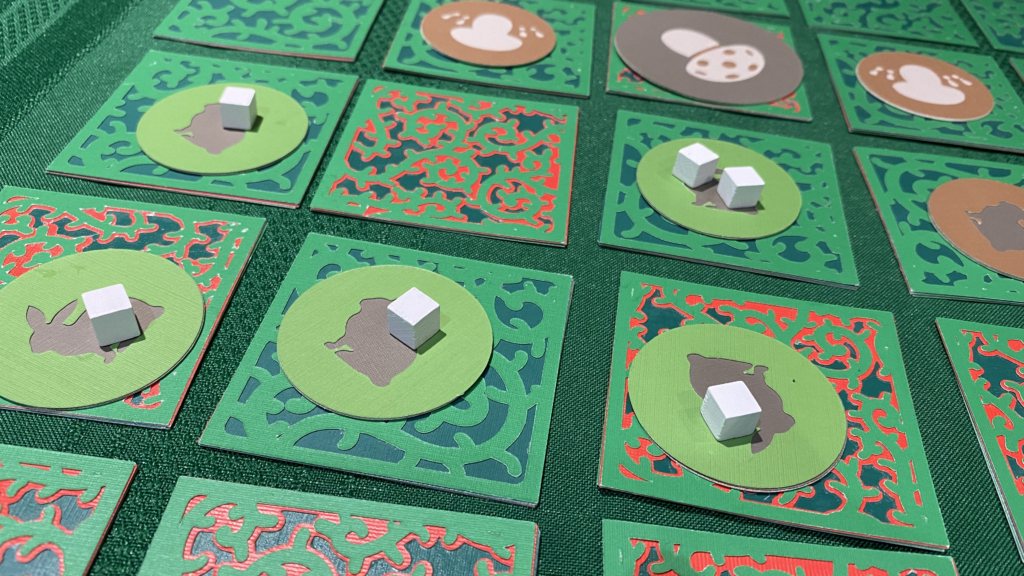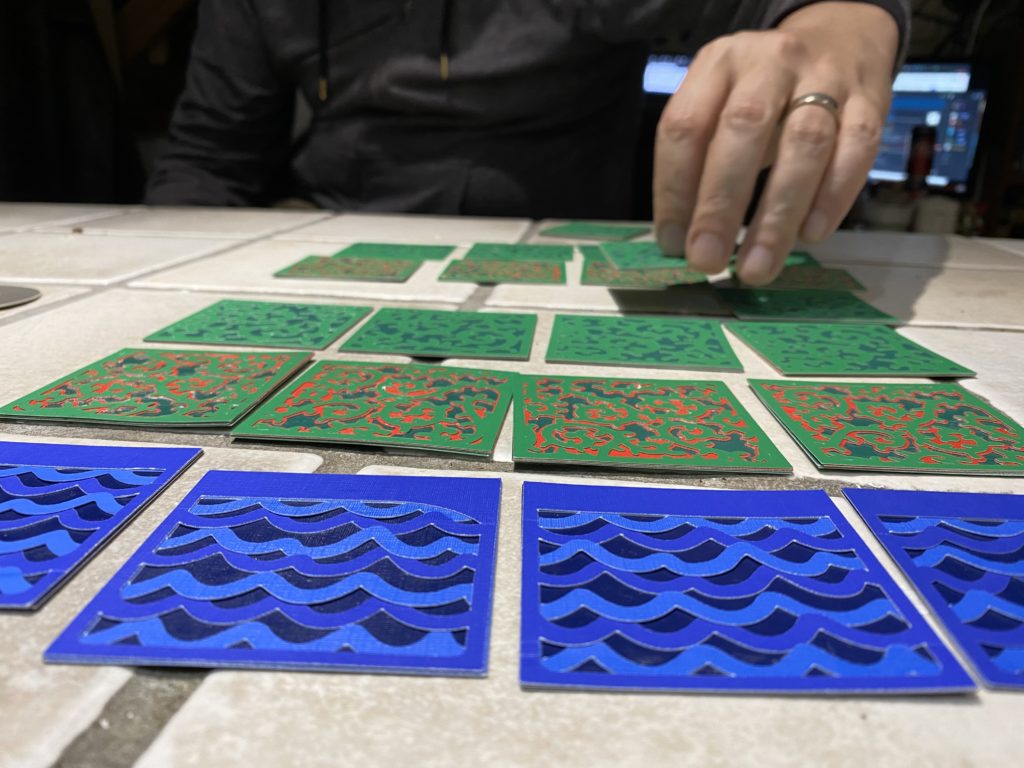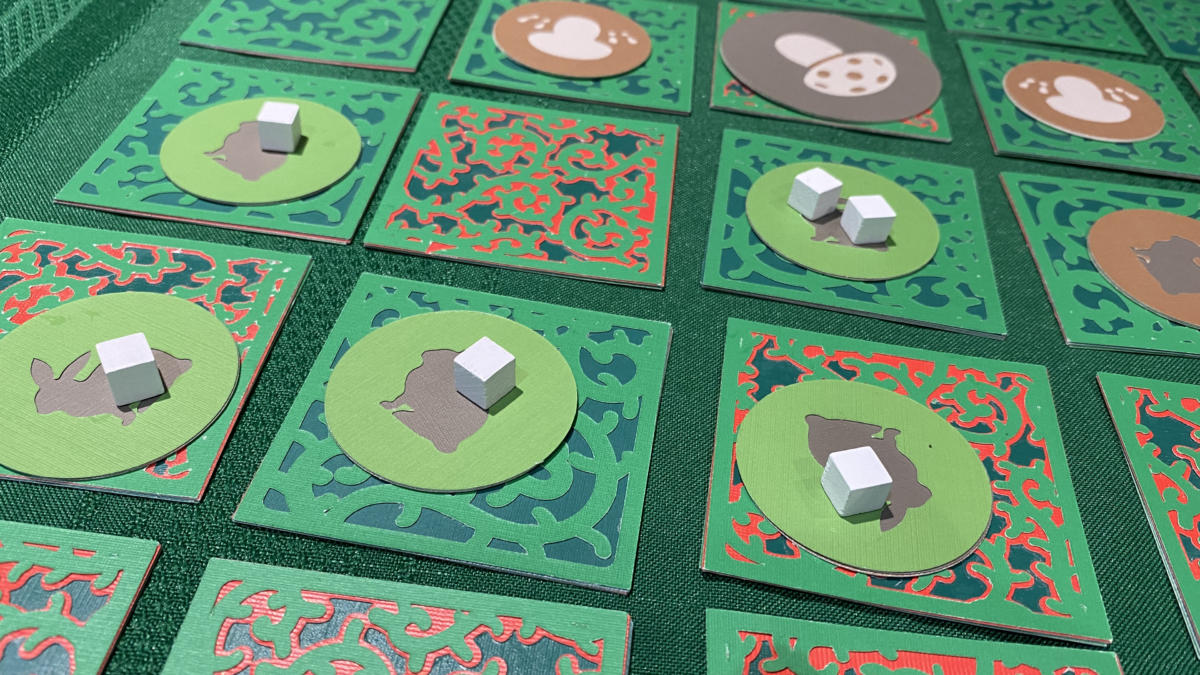Creator: Kay Slater
Exhibition: Posthuman Romantics 2021
Published: February 2021
Format: Board Game
Access: Rules are Downloadable PDF, Video Preview
Content Warning: None, Essay below discusses childbirth and infant mortality.
“In doing some reading on which elements of medieval culture were considered desirable and appealing, I learned that the domestication of rabbits began during those times as livestock for food and clothing. With that piece of trivia, the first of my two post-human rivals emerged.“
Kay Slater
The Work:

[Read or Download The Rules]
I welcome you to create your own game pieces and use this rule set to play out your own game of Brambles & Spores!
Description of the Work
Humans are long gone. A mutagenic ooze flows along the earths surface, rivalling the ocean for supremacy. Nature’s only ally? Giant Sentient Fungi. Bolstered by their armies of fast breeding, irradiated rabbits, they work to restore and rewrite a new ecosystem. However, recent unrest amongst the awakened rabbit factions have slowed down this progress. Rebel rabbits proclaim that brambles and bunnies should be free to go and grow as they please!
Work as Giant Sentient Fungi to restore the landscape, have some snacks, and rework the land as you see best, or fight back as Irradiated Rabbits who only want to eat, and multiply without being controlled by (or be snack food to) a fungal bourgeoise!
A tactical, board game for 1-3 players. [Read or Download The Rules]
Within Post-Human Romantics:
In a post-human setting, Sentient Fungi work to restore a balance after the uncontrolled, and destructive spread of mutagenic ooze has covered most of the earth. They work to become the architects over the new “natural” world, consuming the ooze, and controlling the remaining, nearby fauna to speed (and fuel) their work. A seemingly endless population of rabbits are the other notable force remaining on land, but they are initially easily controlled by the Fungi. At first, there is no resistance but eventually they start to awaken, and begin to question their roles and right to survive in this new hierarchy and “natural” world.
…
Escaping to Nature
“The Romantics often position “nature” as an escape from modernism. They favoured medievalism as a rejection of urban sprawl and industrialism – in my mind, both worth rejecting and questioning, but perhaps not to the point of fetishizing feudal systems and a time before simple machines. Does anyone, who has lived a life with indoor plumbing, wish they could go back to an outhouse? Or to put it in perspective with that timeline, before the smallpox vaccine, the printing press, or the refrigerator? They questioned and rebelled against the bourgeoise, a social class in which many of them belonged. In contemplating the romantics, I thought about what must rebels give up themselves, the hypocrisy and privilege of rebels who have the choice to protest and fight. It’s also hard to ignore, when reviewing the list of Romantic artisans and the famous works, the number of cis-white dudes who carried the movement.
On Babies
Maybe it’s my uterus that makes it difficult for me to buy into the romantic notion of medieval or rustic life. I cannot separate an image of a “natural and pastoral life” from compulsory pregnancy. Even in modern times, pregnancy is a dangerous thing (albeit far less so in a G7 country). Take a step back from a desired and/or supported pregnancy, and the water becomes murkier. With factors such as over-population, religious persecution (within and without), assault, heteronormativity, and ageism – wanting (or not wanting) to be, getting, or being pregnant can be complicated. If it is not yet obvious, it is not, nor has it ever been, desirable for me to become pregnant, but even in modern times in a white and educated body, this opinion was regularly challenged. This body that can become pregnant has been an unwanted chore and a cause for fear, and when it finally ages out of that, I am warned that it will become a disappointment or a regret instead. All of these things swirl about in my brain when one discusses a medieval ideal. No matter how clear the air, or how softly my fictional feet might have tread across the undeveloped country side while I clutched a berry-picking basket and contemplated sparrows, that life with this body would have ultimately been designed to produce babies.
The Mash-Up
All these thoughts about post-Romantic bodies, the privilege and patriarchy in wishing for “simpler times” and access to nature, the act of rebelling against yourself or your own society, scarcity and access to water, food and clean air (and power structure behind its distribution), babies and unchecked birth…led me to bunnies. A creature we automatically associate with innocence, but also reproduction and abundance. That we keep as a pet, and who is considered a pest; docile in a cage, and destructive when free. Consider any fictional, anthropomorphic hare – they are almost always rebels, mad, or outsiders. My favourite among them? PJ Funny Bunny, The American Rabbit, The March Hare, Raving Rabbids, and Usagi Yojimbo, (which is from where comes my decision to include a mutagenic ooze).
So I decided, if one is going to explore a post-human world, one might as well start from the alternate history that began with the Teenage Mutant Ninja Turtles. And there is no doubt at all in mind that Mushrooms will outlive us all.
And so this little game was born.

In Conversation with the Curator:
[Narrator]
Humans are long gone. A mutagenic ooze flows along the earths surface, rivalling the ocean for supremacy. Nature’s only ally? Giant Sentient Fungi. Bolstered by their armies of fast breeding, irradiated rabbits, they work to restore and rewrite a new ecosystem. However, recent unrest amongst the awakened rabbit factions have slowed down this progress. Rebel rabbits proclaim that brambles and bunnies should be free to go and grow as they please!
A tactical, board game for 1-3 players.
[Kay] In coming up with this project, I fell down a bit of a rabbit hole (yes, ha ha) thinking about post-Romantic bodies, the privilege and patriarchy in wishing for “simpler times” and access to nature, and what it meant to give birth in the 1800s. Mortality rates, the dangers that came with an industrial revolution, ever-present colonial sexism, racism and ownership and treatment of human slaves, the birth of modern medicine – still decades (and centuries) away from an understanding, and appreciation, or respect for female and non-male health – it’s difficult to romanticize the 1800 from that vantage point, and even harder to appreciate the emergence of medievalism. In doing some reading on which elements of medieval culture were considered desirable and appealing, I learned that the domestication of rabbits began during those times as livestock for food and clothing. With that piece of trivia, the first of my two post-human rivals emerged.
I began to think about my favourite fictional, anthropomorphic rabbits – they are almost always outsiders or mad rebels. As I built my list, the addition of Usagi Yojimbo led me to the next element in the game – mutagenic ooze.
To be honest, I didn’t dig too deeply when casting the final character. Mushrooms are just super interesting; dangerous, hearty, and adaptive. If ever there was going to be something that outlasted all life on this planet – I figure it’s going to be some variety of fungi.
[Jon] Both the rabbits and fungi in your game have awakened to sentience and are embroiled in a fight for survival and freedom, similar to the way the the French Revolution and Napoleonic Wars (among other things) created the turmoil from which the Romantic movement developed in the 19th century. In the midst of this destruction, surely artists would emerge on both sides. What artistic media and methods would you expect to see from the rabbits? And from the fungi?
[Kay] The Rabbits in my board-game world are as much dominated by the mutagen as by the Mushrooms, but it’s the act of being overtaken and mind-controlled by the fungi that cause them to rebel. They fight against them because they can and because it’s a fight they might win. Meanwhile, the mutagen is a far greater influence and evil in their lives, causing them to be perpetually gestating and that renders them into ooze if they linger too long in one place. But they can’t change or fight against the ooze, and so they don’t. I like to think that these short lived creatures would embrace the abyss by using the ooze and mutagen to pattern and scar their fur in unique and distinctive ways.
The mushrooms practice land art and landscape. The earth is their canvas, and all its creatures and plants, their pigment.
